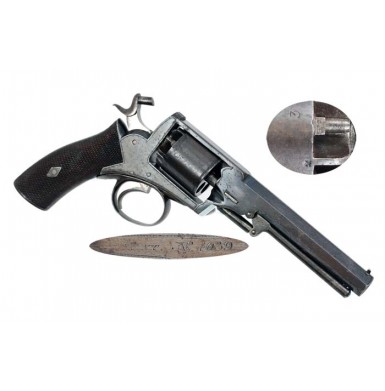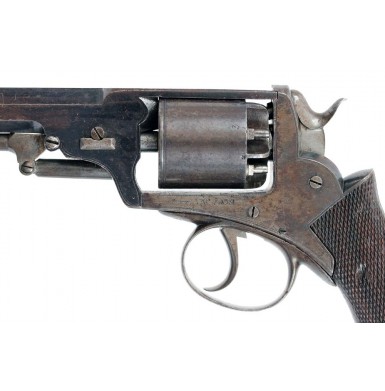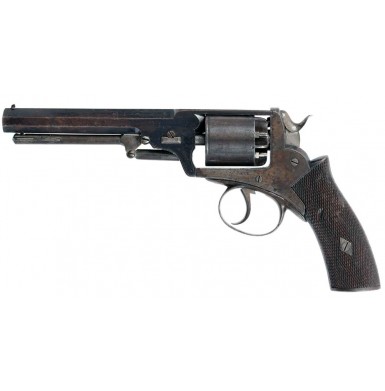Webley Wedge Frame 54-Bore Revolver - Very Fine
- Product Code: FHG-1535-SOLD
- Availability: Out Of Stock
-
$1.00
This is a VERY FINE example of the English Webley Wedge Frame double-action percussion revolver, as produced in the late-1850’s through about the mid-1860’s. These guns provided less expensive alternatives to the Adams and Tranter patent revolvers of the day. The primary cost savings was in the use of a 2-piece frame and barrel design, similar to that of Colt revolvers, with the two parts held together via a “wedge”. Adams and Tranter revolvers utilized one-piece frame/barrel assemblies that were forged from a single piece of iron and were much stronger and less prone to breakage and wear with age. The “wedge” frame design is attributed to Birmingham gun maker Philip Webley, although Webley himself seemed to have manufactured very few of the guns. The simplified double-action lock mechanism typically encountered in these revolvers is usually of the Joseph Bentley design, and these guns are often referred to as Webley-Bentley revolvers, even though they were produced by many Birmingham gun makers and are often unmarked. This Webley wedge frame is very well made and has an action more similar to the Beaumont-Adams than the typical Bentley style double-action only mechanism. The gun has a top strap over the cylinder to reinforce the frame, a feature missing from most Webley-Bentley guns. The gun is typical of larger bore English double-action revolvers in that it features a 5 shot cylinder. Like many Webley style guns, the cylinder chambers are numbered from 1 to 5. The revolver has a 6” long barrel octagon barrel and is chambered in the popular 54-bore caliber (which is about .442). As previously noted the action is more akin to the Beaumont-Adams lockwork of the era, and the gun is a “conventional” double action revolver. It operates as a standard double action by pulling the trigger, which rotates the cylinder, cocks the hammer and releases it, all with one long, heavy trigger pull. The action also allows for more precise shooting. By thumb cocking the hammer and firing the gun in single action mode, a lighter trigger pull is available. In typical English revolver style, the cylinder only “locks up” when the trigger is pulled completely back (in double action mode) or when the hammer is locked in the fully cocked position (single action mode). This eliminates the need for a spring actuated cylinder stop in the bottom of the frame, a feature typical of American guns of the era like those of Colt and Remington. As is commonly encountered on many of the Webley wedge frame guns, the pistol has a Colt-style loading lever under the barrel. The gun bears no retailer markings on the top strap, which is not uncommon. Extant examples of this pattern of Webley Wedge Frame revolver are known with no markings on the top strap, with simply the word LONDON, and with the names P WEBLEY & SON, D. BENTLEY PATENT and J ADAMS (with and without the additional word LONDON). A handful of examples of similar English double action revolvers are known with pre-war Southern retailer marks, usually from New Orleans. New Orleans seems to have been a major source for imported English revolvers prior to the Civil War. Extant examples include guns retailer marked by Thomas Bailey of New Orleans. At least three variations of Bailey’s mark are known on Wedge Frame revolvers. The lower portion of the left side of the frame of this revolver is marked simply PATENT No 4039, below the cylinder. These reliable and reasonably priced double-action revolvers were popular export items and were available for sale around the world. Confederate purchasing agents purchased these revolvers, as they were much less expensive than the competing Adams, Tranter & Kerr patterns. The Pratt Roll, which is an inventory list of revolvers that details the 15 handguns in the possession of Company H of the 18th Virginia Cavalry in July of 1864 lists 3 Webley and / or Bentley revolvers, as well as 4 guns of “unknown” pattern. The balance of the revolvers on the list are 7 Kerr revolvers & 2 Tranter pistols. The Bentley numbers on the list are 3111 and 3221, while the Webley revolver is number 5054. This indicates that even in this small sample of CS used revolvers, at least 20% were of the Webley and/or Bentley patterns. As the average company grade officer would probably not be familiar the names and patterns of English revolver manufactures (other than possibly Adams and Tranter). As a result, I have a feeling that the guns were identified by the maker and/or retailer name on the topstrap of the revolvers. This suggests that #3111 and #3221 were likely “D Bentley” marked Wedge frame revolvers, and #5054 was a Webley marked wedge frame. The “unknown” revolver with serial number 3563 was almost certainly a wedge frame revolver as well, but with no retailer mark on the top strap. The “unknown” revolvers with serial numbers 33,609 and 36,604 were almost certainly Adams patent revolves, also with blank top straps. Based upon the very small sampling of likely “Wedge Frame” revolvers on the Pratt List, this revolver falls exactly in the middle range between the “Bentley” marked guns in the low 3,xxx range and the Webley marked gun in the low 5,XXX range. This pistol is less than 500 numbers from the “unknown” revolver in the 3,5XX range, which was almost certainly an unmarked Wedge frame pistol like this one. While there are no direct Confederate Central Government contracts known for this pattern of revolver, some Confederate correspondence exists that suggest the more reasonably priced double action revolvers (in both 80 bore and 54 bore) were purchased primarily by speculators for importation to the Confederacy. It appears that most of these guns were imported through Mexican or Texas ports and many saw use in the Western Theater and the Trans-Mississippi Theater. It is believed that the revolvers delivered by Nelson Clements (who had a contract to deliver 5,000 revolvers to the Houston Quartermaster) were of the wedge frame pattern. A handful of guns that appear to have been part of his deliveries are known, and they are in the same low 2,XXX serial number range. Additionally, examples of Webley Wedge Frame double action revolvers exist with Confederate provenance. These include a number of well-documented Webley Wedge Frame revolvers in museum collections. The gun of Colonel John Smith of the 20th Alabama Infantry (ex-Bond collection) is one example, as is one reported to be engraved to General William Mahone. Both of these pistols are in the Museum of the Confederacy collection, to the best of my knowledge. Another Webley Wedge Frame revolver, formerly in the famous Richard Steuart Collection, resides at the Virginia Historical Society in Richmond. The Webley Wedge Frame revolver (#5553) is identified to Captain George Russell, the quartermaster of the 47th TN Infantry Regiment.
This double action Webley Wedge Frame is a classic “export” revolver, and is totally unmarked except for the Birmingham proofs and the serial number on the left side of the frame. It is unclear if the gun remains unmarked to keep it “sterile” so that its source could not be easily determined, or if it left blank to be marked by the retailer after export. The gun rates about VERY FINE and retains about 50%+ of its original blued finish on the barrel and top strap. The frame retains only traces of the blue and has a mottled plum brown patina mixed with flecks of finish in the protected areas and some lightly oxidized freckling. The difference in the way the finish wears on these guns is very consistent. Even high condition examples usually retain almost no frame finish, while the barrels and top straps retain lovely blue. I believe this may indicate that the iron/steel alloy used in the frames and barrels were different, resulting in the finish adhering, wearing and surviving very differently. The grip frame retains very little original finish and has a mostly gray patina, with some mottled age discoloration and minor surface oxidation. The cylinder retains about 20% of its original blued finish, which has blended with a lovely plum-brown patina. The cylinder also shows some scattered peppering, pinpricking and lightly oxidized surface freckling. The hammer is in the white, as originally manufactured and retains much of its original bright polish, with some dulling from age. The case hardened, Colt-style loading lever retains about 20% of its original case hardened finish. Most of that has dulled and blended with a smoky gray and tobacco brown color, with some muted highlights still visible. The metal is mostly smooth with only some light scattered patches of minor peppering and pinpricking and some areas of light surface freckling. The revolver is fully functional and mechanically excellent. The pistol functions perfectly in both single action and double action modes. It times and indexes as it should and has very tight lock up. The Colt-style loading lever functions smoothly and locks into place securely. The bore of the revolver rates about FINE. It is mostly bright and retains sharp 14-groove rifling along its entire length. There is some dirt and minor pitting near the muzzle (mostly in the grooves) and much of this might clean out with some scrubbing. The two-piece checkered wood grips are in about VERY GOOD condition with only some light to moderate age wear and flattening from carry and use. The grips are in solid condition, with no breaks, cracks or repairs noted. The only real condition issue worth noting is a fairly deep gouge, about ““ in diameter, on the left grip panel, near the frame juncture. This appears to be the result of some sort of impact during the period of use, as the wood is worn smooth around the edges of the ding.
Overall this is a very attractive example of a rather scarce English percussion revolver. Even though the Confederacy probably imported several thousand of these pistols, they appear for sale only rarely. These guns did not have the name recognition or cache of similar pistols by Adams and Tranter and were probably more likely to have been used in the post war era than saved as mementos of the “late unpleasantness”. These sturdy, workingman’s revolvers certainly saw use during the war, and this one is right in the middle of the serial number range of some of the handful of known, Confederate used Webley Wedge Frame revolvers. This pistol is 100% correct and complete, and functions exactly as it should. It would be a great addition to any collection of Civil War era revolvers and would be equally at home in a collection of typical Confederate used handguns. It is a very fine, large bore pistol that displays well and is rarely seen on the market for sale.
SOLD





